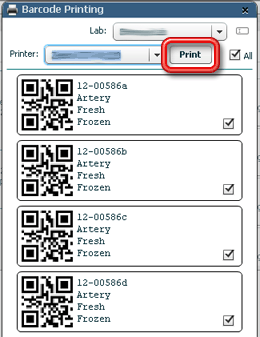- Welcome
- Use case
- Getting Started
-
Searching Records
- Performing a Basic Search
- Performing an Advanced Search
- Performing a List Search
- Performing a Keyword Search of UUMC Pathology Reports for all Patients in the Database
- Performing a Keyword Search of UUMC Pathology Reports for the Patients Associated with a Specific Set of Specimens
- Restrictions on Searches
- Reports
-
iQ Tool
- Adding Columns to a Query
- Starting the iQ Tool
- iQ Tool Window
- Current Query Data Group
- Saved Queries List
- Top Portion of the Selected
- Display or Report Columns Section
- Find/Filters Section
- Running a Preexisting Query
- Creating a Query
- Create Query Window
- Copying and Altering a Preexisting Query
- Removing Columns from a Query
- Editing Column Parameters in a Query
- Changing the Order of Columns in a Query
- Adding Filters to a Query
- Editing Filters in a Query
- Ways of Comparing Data
- Removing Filters From a Query
- Results Window
- Application Data Structure
- Application Database Fields Alphabetical List
- Application Datatree
- Field Paths List for the iQ Tool
-
Adding Specimens to the Database
- Adding a Single Specimen using the Add Specimen Wizard
- Adding a Batch of Specimens using the Add Specimen Expert Tool
- Saving a Batch of Specimens to be added as a Work in Progress
- Finishing a Work in Progress Batch
- Printing Barcodes for a Specimens in a Batch added using the Add Specimen Expert Tool
- Customizing the Add Specimen Expert Tool to Streamline Specimen Batch Entry
- Changing which Box an Add Expert Template Points for Adding Storage
- Importing FFPE Samples from UUMC
- Entering and Editing Specimen Records
- Transformations
- Specimen Disbursement and Registration
- Reports and Records
- Adding a Pathology Report to a Specimen Record
- Performing a DEXT Import of a Pathology Import
- Checking on the status of your DEXT Import Request
- Adding a Medical Record to a Specimen Record
- Editing Patient or Collection Records
- Editing Collection Records
- Editing Patient Records
- Diagnoses
- Adding a Diagnosis to a Patient Record
- Linking an Existing Diagnosis to one or more Collections
- Linking a Collection to a Diagnosis
- Recording a Consent for a Patient
- Reviewing a Patient's Consents
- Uploading a Patient's Consent Form
- Managing Patient Consents
- External (to itBioPath) Data Sources
- Managing Dictionaries
-
Storage
- Editing Aliquots
- Connecting a Barcode Label Printer to itBioPath
- Removing a Barcode Label Printer from itBioPath
- Freezer Management
- Viewing the Contents of a Box in a Freezer
- Accessing the Specimen Record for the Specimen associated with an Aliquot
- Editing Box Details
- Adding a New Box to a Freezer from the Add Aliquot Window
- Managing Protocols, Projects, and Related User Permissions
- Window, Tab, and Field Descriptions
- Miscellaneous
When you have finished adding a batch of specimens using the Add Specimen Expert tool, you may print barcode labels for any or all of the aliquots associated with those specimens. To print the barcodes:
- Start at the end of the Add Specimen Expert Tool process with the Add Results window displayed — see Adding a Batch of Specimens Using the Add Specimen Expert Tool for instructions about adding a batch of specimens using that tool.
- For each specimen in the batch, check (to print barcodes for that specimen) or uncheck (to not print any barcodes for that specimen) the Include in Print checkbox at the end of the specimen details. (As a default, all checkboxes will be checked already.)
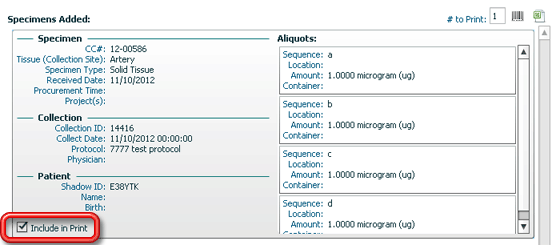
- Enter the number of copies of each label to print in the # to Print field in the top right corner of the window.
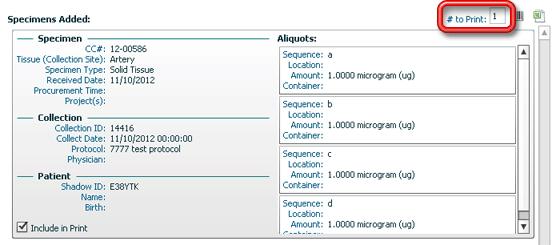
- Click on the barcode icon next to that field. The Barcode Printing window will appear, displaying images of each of the barcode labels to be printed.
![]()
- Select the Lab and the Printer to print the barcode labels on in the fields at the top of the Barcode Printing window.
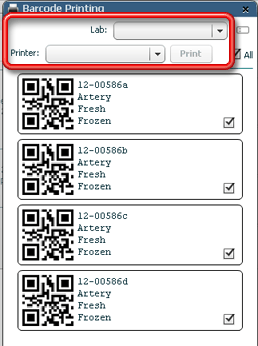
- To print only some of the labels, check or uncheck the checkbox in the lower right corner of each label. Checked labels will be printed and unchecked labels will not. (This allows you to print the labels for only specific aliquots from a specimen. The previous window selections were made for the entire specimen only.) By default, all labels will be checked.
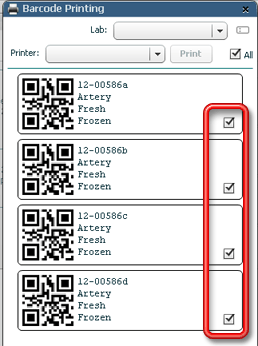
-
Check or uncheck all labels at the same time by using the All checkbox at the top of the list.
-
Click the Print button to send the selected labels to the selected printer to be printed.
